HOW DO ORGANISMS REPRODUCE for Class 10 BIOLOGY
INTRODUCTION
Chapter Weightage
Types Of Reproduction
- Reproduction wo biological process hai jis se ek organism apni offspring (balak) paida karta hai yeah paaka karne ke liye ki future me uska vansh badhta rahe. Prithvi par reh rahe sabhi organisms ke apne tareeke hai reproduce karne ke jinko hum broadly 2 modes me divide kar sakte hai : Asexual mode of reprodcution and Sexual mode of reproduction based on phenomenon whether gametes (sex cells) ki formation hui hai ya nahi. Agar reproduction me gametes ki formation nahi hoti toh yeah asexual mode of reprodcution hai and agar gametes ki formation hoti hai toh wo sexual mode hai plus sexual mode me opposite sex ke (usually) 2 parents involved hote hai jabki asexual me ek hi individual parent hota hai.
- Ab next section me hum in dono modes ko detail me study karenge.
Types Of Reproduction
- There are two main methods in which new organisms (Offspring) are produced from their existing organisms (Parent):
- Asexual Reproduction : No gamete formation and a single parent is involved.
- Sexual Reproduction : Gametes are produced usually from 2 parents of opposite sex.
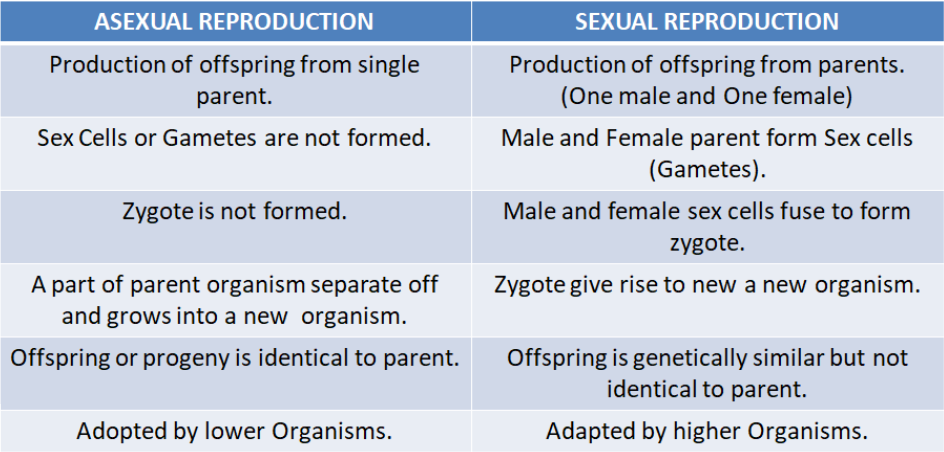
Types Of Asexual Reproduction
- Asexual word ko part me segregate karein toh we get : A (absent) + Sexual (sexual way) yani ki reproduction ka aisa tareeka jisme sexual components like male and female parent ki involvement ya gamete ki formation absent ho. Toh yeah reproduction ka ek simple primitive (purana) mode hai jo generally hume prokaryotic cells (Bacteria vagarah) and kuch Eukaryotic cells (like Planaria, Hydra vgarah) me dekhne ko milta hai. Asexual reproduction bhi kafi alag alag tarike se ho skti hai toh ab hum asexual reproduction ke different types padhenge :
- BINARY FISSION : iske naam me hi definition hai. Dekho ab “Binary” ka matlab hota hai 2 and “fission” ka matlab hota hai split karna toh iss process me ek parent cell khud 2 chote daughter cells me divide/split kar jata hai. Yeah process generally single celled prokaryotes like bacteria, amoeba etc me hoti hai. Ab yeah fission agar cell ki longitudinal axis (vertical axis) ke along hota hai toh it is LONGITUDINAL BINARY FISSION and agar cell transverse section (horizontal axis) ke along divide karta hai toh then this is known as TRANSVERSE BINARY FISSION.
- MULTIPLE FISSION : multiple ka matlab hota hai many and fission ka matlab is splitting toh multiple fission aisa mode hai jisme ek hi parent cell bahut sare daughter cells me split kar jata hai. Yeah process hoti hai Plasmodiumme. Toh generally hota yeah hai ki pehly nucleus bahut sare chote chote nuclei me divide kar jata hai jiske baad thoda thoda cytoplasm har daughter nuclei ko surround karta hai and then ek membrane ki formation shuru hojati hai. Toh last me hume ek hi cell ke ander bahut sare daughter cells hote hain. This cell splits and these daughter cells are released.
- FRAGMENTATION same yha bhi naam me hi definition hai ki ek organism accidentally khud bahut sari fragments/tukdo me tut jata hai and then har part se ek new organism ban jata hai. Ex: Spirogyra me yeah process hoti hai.
- REGENERATION Re ka matlab hota hai dobara and generation ka matlab yha hai ugna ya paida karna. Toh iss procees me generally hota yeah hai ki agar organism ko iss tarike se split kiya jaye ki usme original organism ke har type ke cell present ho toh uss organism ke ek part se ek nya waisa hi oranism ban jata hai. Ex : Planaria.
- BUDDING : isme parent body par hi hume kuch nearly round shape ki outgrowths (jinko 'bud' bola jata hai) dekhne ko milti jo mature hone k baad parent body se detach/alag hokr neehe mitti me gir jati hai and ek new organism me grow karna start kar deti hai. Ex : hydra
- VEGETATIVE PROPAGATION : Iss mode me plant ka vegetative part (stem, root, leaves etc.) new plant produce karta hai. This process is not applicable for animals. Vegetative propagation bhi 2 types se ho sakti hai : ya natural ya toh artificial ho.
→ Sweet potato ek modified root hai and usko soil me rakhne k baad ussi se ek new plant aajata hai toh this natural vegetative propagation by root similarly potato (modified stem) ke uper aapne green colour notches dekhi hongi jinko hum eyes of potato kehty hain. Inhi eyes se favourable condition me ek new plant ban jata hai. Toh yeah natural vegetative propagation by stem. Money plant (Bryophyllum) ki leaves ke jo margins hote hain vahan par kuch buds bn jate hain jo kuch time baad choti choti saplings me badal jati hain and jab jab yeah saplings leaves se detach hoker jameen par girti hai toh germination ke liye favourable conditions ki availability hote hi yeah saplings ek new plant me grow kar jate hain. So this was natural vegetative propagation by leaves.
Next we have artificial vegetative propagation jisme mainly humko 3 cheezein study karni hai : Layering, Grafting and cutting.- GRAFTING : isme hum ek plant ko stem se cut karte hain (this plant is known as scion) and ek plant jiski roots soil me hi rhti hai (stock) uss plant ki stem me ek hlka sa aisa cut lagate hain taki scion ko vahan join kar sake. Fir yeah dono plant ek sath ek hi plant ki tarah grow karna shuru kar detey hain. Ex : Mango, Apple etc.
- CUTTING : is method me plant ke ek vegetative part jaisey ki root, stem ya leaf me cut laga kar usko soil me place kar detey hai uss part se ek new plant grow kar jata hai. For generally Rose ki propagation ke liye aapne suna hoga ki gardener rose ki ‘Kalam’ lgata hai. That kalam is stem cut at an angle itself.
- LAYERING : iss method me plant ki ek branch ko bend karke usko mitti me daba detey hain without cutting it completely from the main plant. Fir usme root develop ho jati hain and wo apne aap parent plant se detach ho jata hai. Ex : rose, jasmine, grapes etc.
- TISSUE CULTURE : iss method me hum plant ke vegetative hisse se meristem tissue ko lekr, usko lab me grow karte hain. Nutrition ke sath sath different hormones ka ek balance rakhna padta hai and dherey dherey tissue grow karke callus bnata hai and then root and stem me differentiate ho kar choti choti plantlets me grow kr jate hain jinko fir soil me plant kar diya jata hai. Toh aise hi ek plant se bahut sare plant aur grow kiye ja sakte hain.
- SPORE FORMATION : unfavourable condition me kuch organisms like bacteria, algae and fungi form spores. Jaise jo condition favourable hoti hai yeah spore firse new plants me germinate kar jate hain. Jo sac like structure in spore ko hold karke rakhta hai, that structure is known as sporangium.
Types Of Asexual Reproduction
FISSION
- The word Fission means Dividing.
- In this process, parent cell divides/splits into two or many daughter cells.
- It usually occur in single celled organisms like bacteria and protozoa.
- Fission is of two types:
- BINARY FISSION : In binary fission, the parent cell splits into two daughter cells (equal halves).
- Steps involved in Binary Fission:

- BINARY FISSION : In binary fission, the parent cell splits into two daughter cells (equal halves).
- Binary fission is of three types on the basis of the plane of cytokinesis:
- Simple Binary Fission
It is also known as a regular binary fission.
The division of cytoplasm or cytokinesis can occur along any plane.
- Longitudinal Binary Fission
Leishmania (which causes kala-azar ), which has a whip-like structure at one end of the cell.
In such organisms, cytokinesis occurs along a longitudinal plane.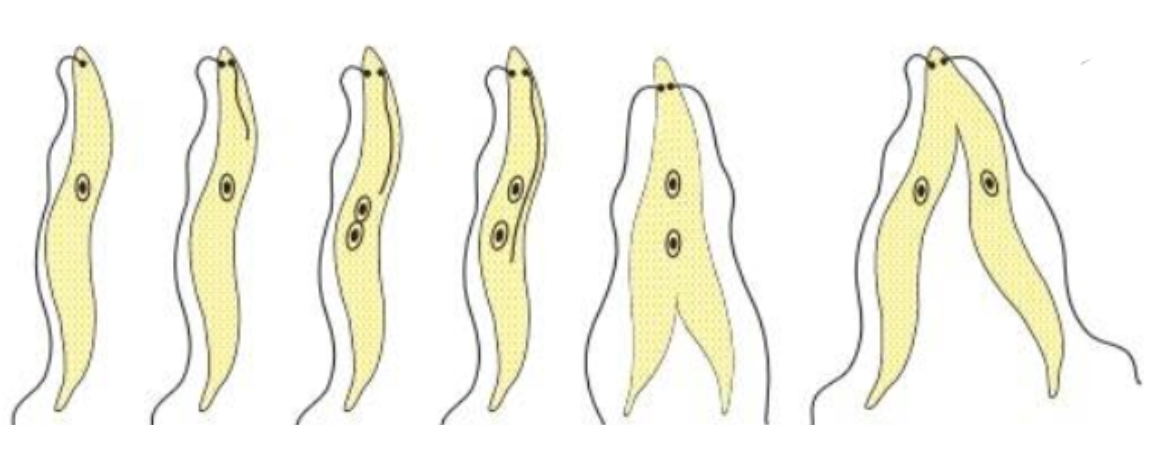
- Transverse Binary Fission
The division of cytoplasm or cytokinesis can occur along transverse axis.
Example: Paramecium.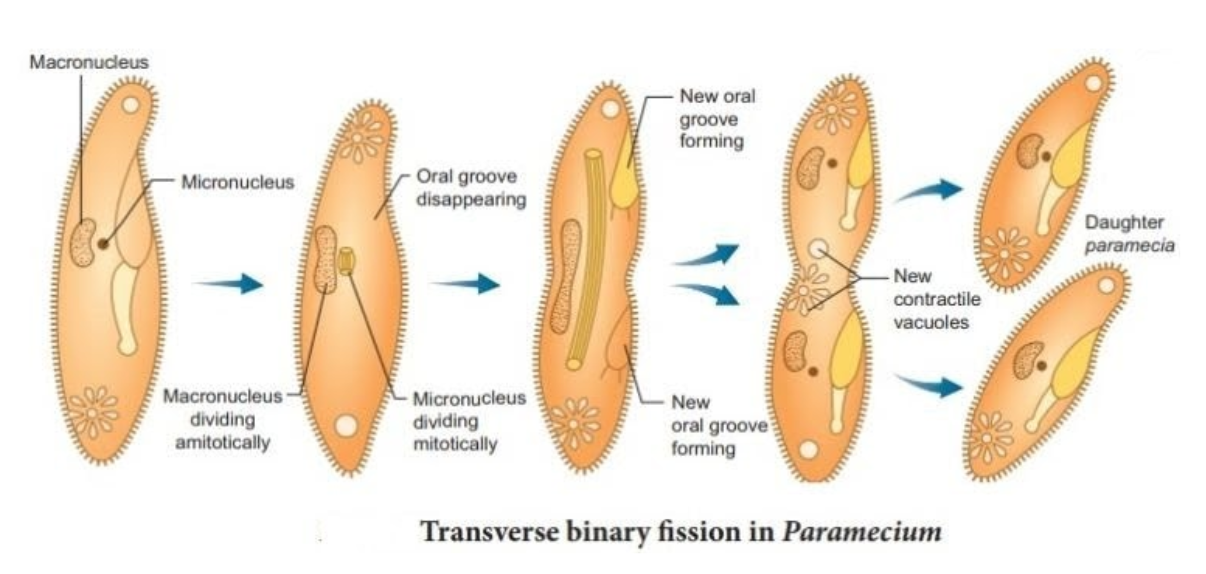
- Simple Binary Fission
-In Multiple Fission, parent cell splits/divides into many daughter cells. Steps involved in Multiple Fission:

FRAGMENTATION
- In some organisms with lower organisation, the body breaks up into many pieces upon maturation and each piece develops into a new individual.
- Example: Spirogyra, Sea anemone etc.

REGENERATION
- Some organisms with higher organisation have capability to give rise to new individuals from their body parts.
- For example, when Hydra and Planaria are somehow cut and broken into many pieces, each piece grows into a complete individual, this process is called Regeneration.


BUDDING
- In Budding, a small outgrowth develops on parents as “Bud” due to repeated division at specific sites.
- This bud develops as tiny individuals,detaches from the parent body upon maturation and develops new independent individuals.
- Example: Hydra.
- Some unicellular organisms also reproduce by budding e.g. Yeast.
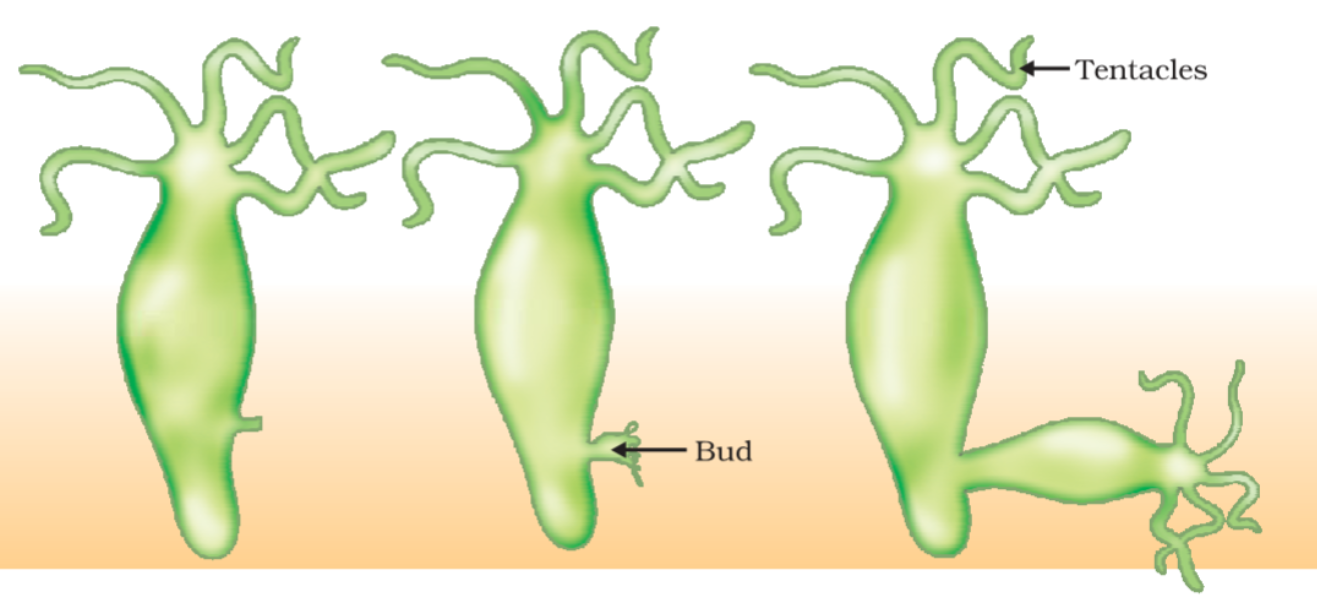
-In yeast, a small bud is formed on the parent cell. The nucleus of parent cell divides and migrates into the bud.
-This bud develops into a tiny yeast cell, detaches from parent yeast upon maturation and becomes an independent individual.

- In this type of asexual reproduction, a vegetative plant part produces a new plant.
- Plants raised by vegetative propagation can bear flowers and fruits earlier than those produced from seeds.
- Such methods also make possible the propagation of plants such as banana, orange, rose and jasmine that have lost the capacity to produce seeds.
- Another advantage of vegetative propagation is that all plants produced are genetically similar enough to the parent plant to have all its characteristics.
- Vegetative reproduction occurs via two main methods:
- By Root
E.g. Sweet Potato, it is a modified root which give rise to a new plant when kept under the soil.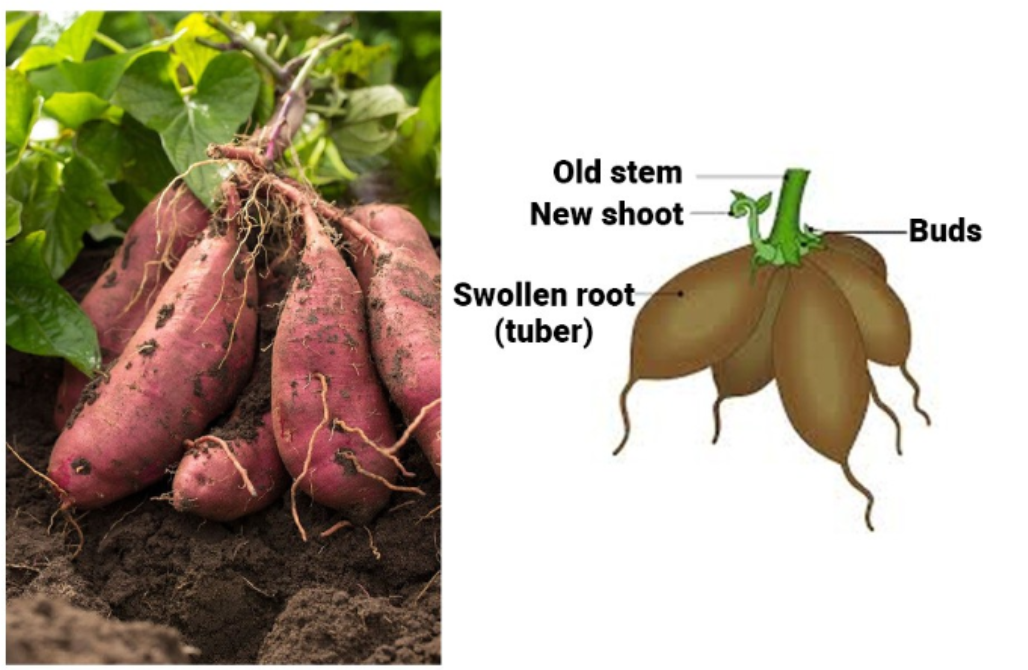
- By Stem
E.g. Potato, many notches called “Eyes of Potato” are present on the surface of the potato. Under the favourable condition, each eye gives rise to produces a new plant.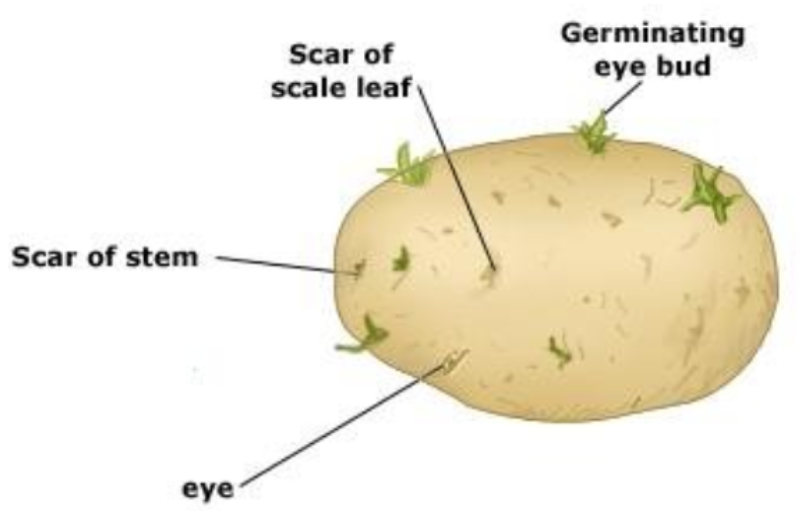
- By Leaves
E.g. Bryophyllum leaf has notches on the margins, the latter bear buds which develop into small saplings when the leaf is put under the soil. - Grafting
- This method combines the desirable characteristics of two varieties of plant.
- The stem of a plant is cut off such that its roots are still in the soil. This plant is called stock.
- A stem from another healthy plant named the scion is placed over stock.
- The scion and stock are tied together tightly.
- Examples: Mango, Rose, Apple etc.
- Cutting
- In this method a small part of root, stem or leaf is cut and placed or planted in soil.
- This planted part develops root and forms a new plant.
- Examples: Rose, Hibiscus etc.
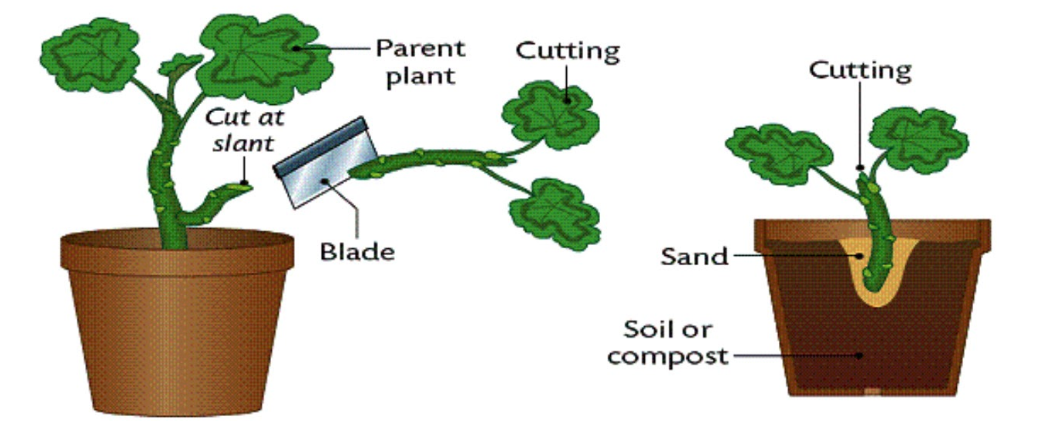

1). Natural Methods
The process of development of new plants from the parent plant part (Root, Leaves, and Stem) by natural methods is called Natural Propagation of plants.

2). Artificial Methods
The process of growing many plants from parent plants part by man-made methods is called the Artificial Propagation of plants.
- In this method, a stem or branch is bent to the ground.
- A small part of the stem is buried under the soil so that root develops there.
- It is then finally detached from the parent plant.
- Examples: Grapes, Climbing roses, Jasmine etc.
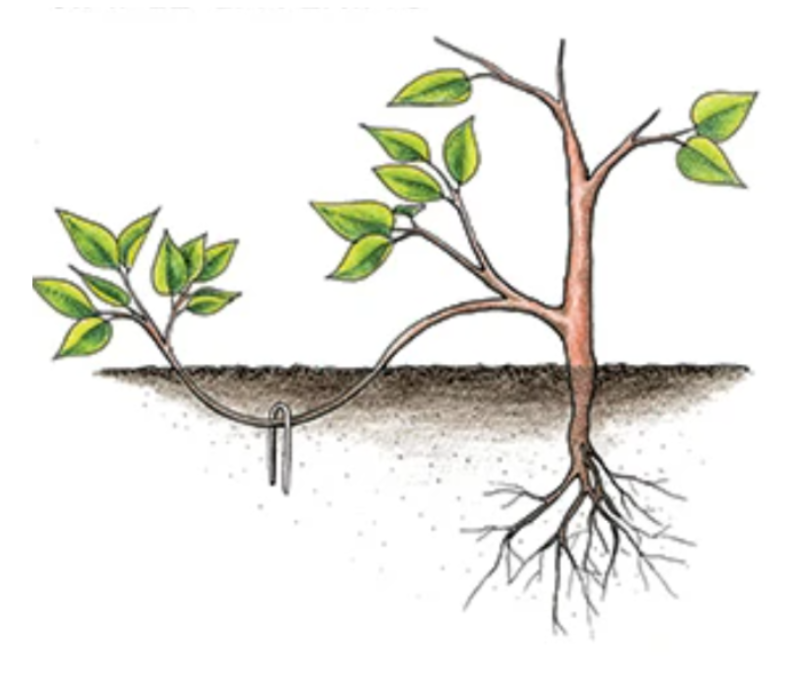
- In this process, new plants are produced by using a small piece of plant tissue (cells) removed from growing tips of a plant in a suitable medium.
- Steps involved in tissue culture:


SPORE FORMATION
- Spores are small bulb-like structures which are covered by thick walls.
- These spores are formed in a special spore-bearing organ called sporangium.
- These sporangium in turn are born on a special thread-like, erect structure called Hyphae (Sporangiophores).
- Under favourable conditions, sporangium bursts and releases spores. These spores germinate and produce new organisms.
- Example: Rhizopus.
Note: These thick walls protect spore from unfavourable conditions.
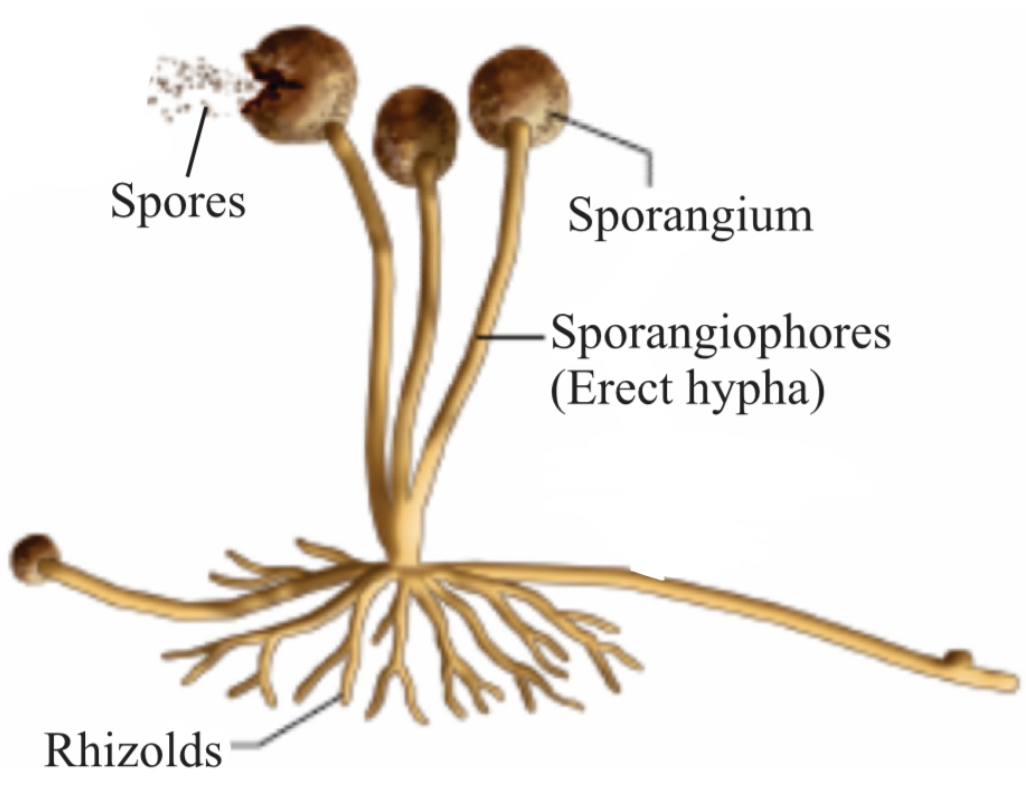
Sexual Reproduction
- Sexual reproduction me 2 parents (male and female) se male and female gametes ki formation hoti hai. Yeah gametes ek dusre ke sath fuse karke ek single celled zygote bnate hai jo ki future progeny ka pehla hai. Fir zygote aage aur grow krta hai into a complete individual. Yeah basic pattern sexually reproducing organisms me common hai.
- Some flowers are unisexual (either male or female) and some are bisexual (having both male and female components). Generally ek bisexual flower ke 4 components jote hain : petals (pankhudiyaan (which are generally coloured)), sepals (green colour ki protective sheath hoti jo flower ke open hone ke baad petals ke niche green colour ki pattiyon ki tarah dikhti hai), male part (stamens / Androecium) and the female part (Gynoecium/ carpel / pistil).
- Stamen ke 2 parts hote hain : ek lamba patla sa filament like structure jisko stalk kehte hain and top par ek swollen part jisko anther kehte hain. Anther ke ander ki pollen grains ka production hota hai jinme male gamete banega.
- Gynoecium ke 3 parts hote hain : Stigma (top swollen part, style (middle hollow tube like structure), and last part is ovary which contains female gamete - egg.
- Jab reproduction ka time aata hai toh pollen grains ka anther se stigma par transfer hota hai and this process is known as Pollination. Pollination wind, water ke through bhi ho sakta hai (by Abiotic Agencies) ya pollination animals jaise ki bees, insects, snakes, human, snails ke through bhi ho sakta hai (by Biotic Agents). Pollination ke bhi 2 types hain :
- Self Pollination : jab ek hi flower ke anther se ussi flower ke stigma par pollen grains ka transfer hota hai ya ek hi plant ke ek male flower se ussi plant ke female flower tak pollen grains ka transfer hota hai toh it is known as self pollination kyunki pollination genetically similar flowers me hua hai. It maintains the purity of a breed but ek nuksaan yeah hai ki lambe samay tak self pollination ke karan inbreeding depression (progenies sterile paida hony lagti hai) ka akhatra badh jata hai.
- Cross Pollination : jab ek plant ke male flower se ussi species ke kisi dusre plant ke female flower par pollen grain ka transfer hota hai toh it is known as cross pollination. Yeah progeny me variety badhta hai, yahi iska sabse bda advantage hai.
- Ab jab pollination ho chuka hai toh pollen grain stigma par germinate karna shuru kar deta hai and during germination pollen grain se ek pollen tube nikalti hai jisme male gamete hota hai and yeah pollen tube style ke through ovary ko penetrate karti hai jahan female gamete hota hai. Male and female gametes fuse with each other and a single celled zygote is formed. Issi fusion ki process ko fertilisation kehte hai.
- Fertilisation ke baad jitni bhi cheezein hoti hai they are known as post fertilisation events like ovary ka fruit me ripe hona, ovary ke ander seed ki formation honi, petals and sepals ka sukh kar gir jana yeah sabhi post fertilsation events kehlate hain.
- Seed ki protective layer ko seed coat kehte hain jo ki bilayered structure hai jiski outer layer testa hoti hai and inner layer tegmen hoti hain. Seed ke ander embryo hota hai toh seed coat seed ko protect karte hain. Seed ke ander hi cotyledons ho bhi sakte hain jo embryo ke liye food ka reserved source hai. Jaise hi favourable condition aayegi and seed ko soil me plant kiya jata hai, the seed grows into a new plant.
Ab hum discuss karenge sexual reproduction in flowering plants :
Sexual Reproduction
- It is the most evolved process of reproduction, which involves two sexes a male and a female.
- Sexual reproduction occurs nearly in all animals including those which reproduce asexually.
- Males form male sex cells/male germ cells and females produce female sex cells/female germ cells.
- Sex cells are also known as gametes, these cells come together during fertilization and fuse to form a zygote.
- Zygote divides to form an embryo, which ultimately develops into a new individual.
SEXUAL REPRODUCTION IN FLOWERING PLANTS
- Flowers are the reproductive organs of plants. A typical flower usually consists of four whorls: Sepals, Petals, Stamens (Androecium) and Carpels (Gynoecium).
- SEPALS
- Green, leaf-like and Outermost whorl of the flower.
- All sepals taken together are called calyx.
- calyx product flower during its initial stages when a flower is in its bud form.
- PETALS
- Usually Brightly coloured, lie inside of the sepals.
- All petals taken together are called Corolla.
- Corolla attracts insects for pollination.
- STAMENS
- It is the male reproductive organ of the flower (plant), lying inner to petals.
- It consists of two parts: a stalk and a swollen top, the former is called Filament and the latter is known as Anther.
- Anther a produces yellowish powder-like substance called Pollen Grains, it contains male gametes (Male sex cells).
- CARPEL (PISTIL)
- It is the female reproductive organ of a flower, lying in the centre.
- Is made up of three parts:
- Stigma: top-most part, sticky and receive pollen grains from anther during pollination.
- Style: middle tube which connects stigma to ovary.
- Ovary: Swollen bottom part, Ovary makes ovule which contain female gamete (Female sex cell).
- NOTE: The base of the flower to which all parts are attached is called Thalamus or Receptacle.
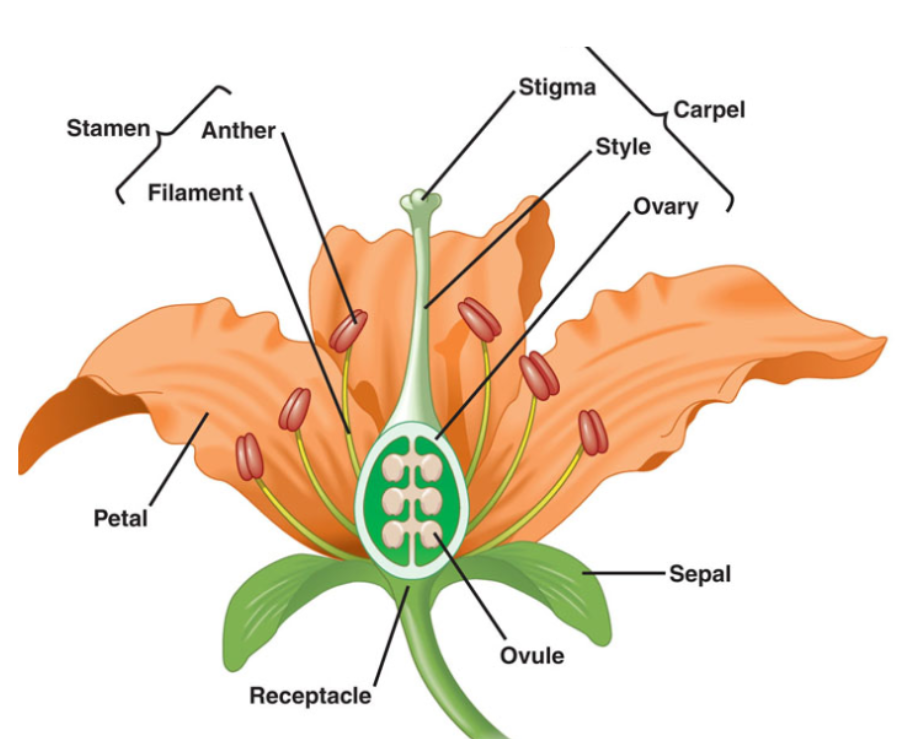
STRUCTURE OF FLOWER :
TYPES OF FLOWERS
- Unisexual Flower: Either male or female reproductive part is present. E. g., Papaya, watermelon.
- Bisexual Flower: Both male and female reproductive parts are present. E. g., Hibiscus, mustard.
STEPS INVOLVED IN REPRODUCTION
- POLLINATION : The process of transfer of pollen grains from anther (of stamen) to stigma (of ovary) is known as pollination.Pollination can occur in two ways:

- FERTILISATION : After a pollen grain falls on stigma, the second step is fertilization in which a male gamete present in pollen grain fuses with the female gamete present in ovule.
Pre-Fertilisation Events :- When a suitable pollen grain falls on stigma.
- A mature stigma secretes chemical substances which stimulate pollen grain to germinate on it.
- Germinated pollen grain produces a pollen tube, it carries male gamete at its tip and grows by penetrating the tissues of Style and reaches the ovary.
- Pollen tube continues to grow until it enters the ovule where it finally releases male gamete.
- The male gamete fuses with the female gamete present in ovule and forms zygote.

Post-Fertilisation Events :- After fertilization, Ovule develops a tough coat and gradually converts itself into seed which contains zygote.
- Zygote undergoes several rounds of mitosis and becomes an embryo which finally develops into a new plant.
- Thus a seed is also known as the reproductive unit of a plant (which can be used to grow new plants).
- Meanwhile ovary grows rapidly and ripens to become a fruit and other parts of flower (Petals, sepal, stamens, style and stigma) fall off.
- GERMINATION OF SEEDS : It is a process which involves emergence of a plant from a seed when it is provided with proper temperature, air, moisture and water. A typical seed consists of:
- Seed coat: Provide protection to embryo.
- Cotyledons: Also called seed-leaves, contain reserve food material for developing embryo.
- Embryo: Will give rise to a new plant.
Process of Germination :
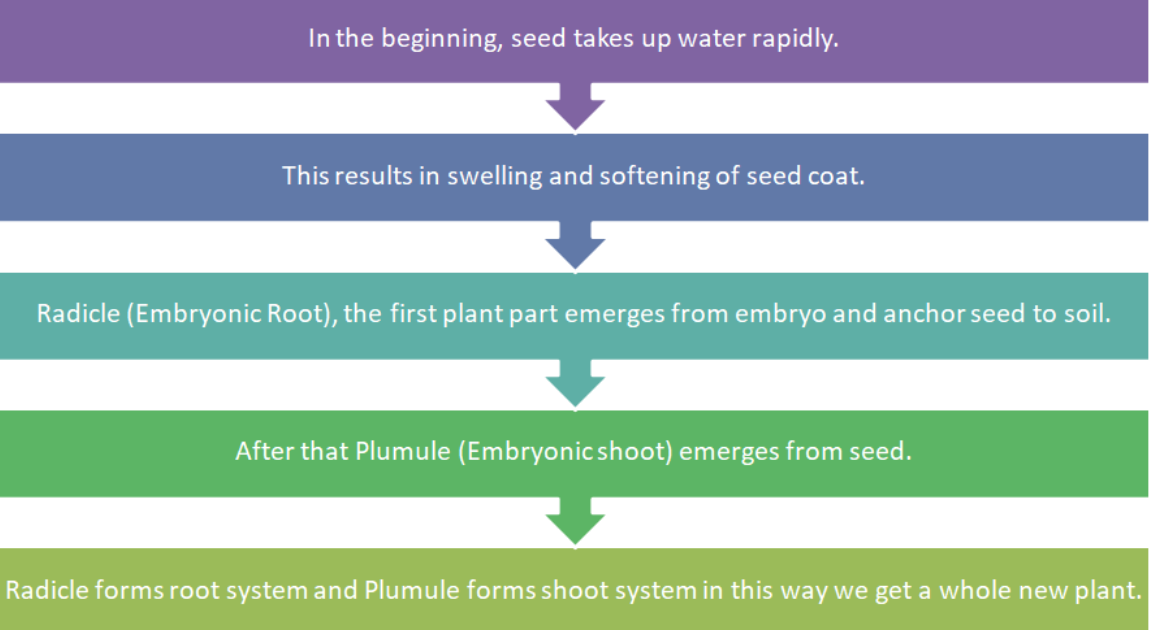
Sexual Reproduction In Humans
- Humans me bhi sexual reproduction ke time par male and female sex cells / gametes ki formation hoti hai. Unka fusion hoga, zygote banta hai and mother ke womb me kuch specific time ke liye (gestation period) grow karega and when its fully developed it is delivered. Toh yeah ek bahut hi basic sa concept tha but ab hum iski detail padhenge.
- Humans birth k baad kuch saalo ke liye grow karty hain before they are capable of sexually reproducing toh birth se lekar wo time jab tak bacha sexually mature nahi hota, life ka wo time period juvenile age kehlata hai. Then nearly at the age of 11-13 years they start to mature sexually and unke sharir me aisey changes hony lagte hain which indicate that a person is on their journey to be a sexually mature individual. Aapki body me aise changes hone lagte hain jisse aapki physical appearence change hone lagti hai, these changes generally happen due to sex hormones. Male and female me principal hormone and changes alag alag hote hain jo hum ek ek karke abhi discuss karenge.
- PUBERTY: yeah wo umar hai tab balak sexually mature hona shuru karte hai. Generally females start to mature 1-2 yrs before toh normal age male and female ke liye 11-13 yrs ki hoti hai on an average. Kuch individual thoda sa early mature hona shuru kar detey hain and kuch thoda sa late and dono hi conditions healthy hai kyunki har kisi ki body alag hoti hai and it takes its own time to prepare itself.
- Males jab puberty par aaty hain toh unke primary sex organ yani ki testis, TESTOSTERONE hormone produce karte hain jiske vajah se unki puri physical appearance par effect aata hai jaisey ki voice deep hona shuru ho jati hai, facial hair and body hair growth badh jati hai sath hi sex organs mature hone shuru hote hain, broadening of shoulders, easy gain of muscle mass, increased bone density, pubic hair ki growth hona yeah sab secondary sexual characteristics hotey hain ji hume indirectly yeah btate hain ki yeah individual ab sexually mature hai.
- Similarly females me ovaries se ESTROGEN and PROGESTERONE ki formation female secondary sexual characteristics ko promote karta hai such as increased voice sharpness, growth of breasts, menstrual cycle begins, growth of pubic hair in genitals and groin, broadening of hips, increased fat deposition to conserve energy.
- Primary sex organs wo hote hain jahan gametes ki formation hoti hai and jo structure gamete ki nourishment and transport me help karte hain they are knowna as secondary sex organs. So males me primary sex organs hue : testes and females me priamry sex organs hote hain : ovaries. Secondary sex organs male me hue accessory glands, ducts and external genitalia (Penis) and females me secondary sex organs hote hain oviducts, womb and external genitalia.
- Males me testes abdomen se bahar scrotal sac me hang isliye karte hain kyunki testes ko male gametes (sperms) bnane ke liye normal body temperature se 2-2.5oC temperature less required hota hai. Sperms testes me bante hain and then vahan se unko ducts se transport kakre urethra tak pahuchaya jata hai. Penis me erectile tissue hota hai jisme blood flow increase hone ke baad erection sustain kiya jata hai so that sperms can be easily transported upto female's reproductive tract.
- Males me kuch accessory glands hote hain like seminal vesicles, prostate glands and bulbourethral glands. Inn glands ki secretion sperm cells ko nutrition provide karti hain and urethra ko lubricate karti hain so that sperms easily travel kar sake and also urine ke karan jo acidic environment urethra ka tha, usko ko neutralise kar diya jata hai.
- Females me external genitalia me we have an elastic stretchable hollow tube like structure to receive penis, this structure is called as vagina which on the inside opens into the womb via an opening known as cervix. Sperms yahan se uper ki taraf swim karte hue fallopian tube me pahuch jate hain jahan female sex cell (ovum/egg) ke sath uska fusion hota hai and it forms a zygote. Zygote then grow karke embryo bn jata hai. Embryo mother ke womb me embed ho jata hai so that it can take nutrition from mother’s blood. Issi process ko hum Implantation kehte hain. Implantation ke baad placenta ki formation ho jati hai jo mother ke blood se nutrition lekar baby ko degi and baby se waste product lekar mother ke blood me dump karegi. Then mother ki kidney uss waste ko filter karke excrete karti hain.
- Baby fully develop hone ke baad mom ko signal send karta hai jise mother ke uterus me contraction hote hain so as to push the baby outside the womb taki baby ki delivery ho sakey.
- Agar ek couple ko pregnancy avoid karni hai toh there are some contraceptive methods jo yeah ensure karte hain ki male and female gamete ka fusion na ho and zygote ki formation na ho sake. Agar fertilisation ho chuki hai toh inme se kuch aise methods hain jo womb ko implantation ke liye unstable bana dete hain. So physical barrier methods me we have condoms, diaphragm etc jo fertilisation ko prevent karte hai. Intra Uterine Devices (IUDs) aisey devices hote hain jinko female ke uterus me place kiya jata hai and they prevent fertilisation by killing sperms inside the female body ya fir uterus ka environmemnt aisa hoga ki uss environment me embryo sustain hi na reh paye. They are also some hormonal pills and some non steroidal pills which are taken orally. Yeah pills bhi hormonal balance ko iss tareeke se disturb karte hain taki pregnancy sustain na ki ja sake. Even surgical methods bhi hain like tubectomy females me (iss method me surgeon surgically oviducts ko cut karke tie kar deta hai so that ova/egg fallopian tube me fertilisation ki site par na ja sake) and vasectomy males me (jisme males ke vas deferens ko cut karke tie kar diya jata hai so that sperms urethra tak travel na kar paye), but yeah almost permanent methods hai and inko reverse karna mushkil hota hai.
Sexual Reproduction In Humans
- Humans show the sexual mode of reproduction and involves the formation of specialized sex cells or gametes.
- The period of life when production of gametes i.e ova and sperm starts in the body is called the period of sexual maturation or puberty.
- It is the age or period, when the reproductive organs of a child starts functioning and he/she attains sexual maturity.
- In girls, it is achieved at the age of 10-12 years.
- In boys, it is achieved at the age of 13-14 years.
- The functioning of the reproductive system also has effects on other systems all around the body and cause various changes.
- These changes are also called secondary sexual characters, these are different in two sexes.
- Changes seen in boys during puberty:
- Slow growth of mustaches and beard.
- Thick Hair growth in the armpit and pubic region.
- Broadening of shoulders.
- Voice begins to crack.
- Skin becomes oily, may result in pimples.
- These changes are caused by male sex hormones called testosterone.
- Changes seen in girls during puberty:
- Breast size begins to increase.
- Thick Hair growth in the armpit and pubic or genital region.
-Girls begin to menstruate. - Skin becomes oily, may result in pimples.
- These changes are caused by the female sex hormone called Oestrogen and Progesterone.
- Primary sex organs
- These organs produce germ cells or gametes.
- Example: Testes in males and ovaries in females.
- Secondary sex organs
- These organs help in transport and nourishment of gametes.
- Example: Vas deferens, Urethra, and various glands in males, Fallopian tube in females.
- A pair of testes are located inside scrotum which is present outside the abdominal cavity.
- Scrotum a pouch-like structure provides a relatively lower temperature needed for the production of sperms.
- Male germ cells i.e. sperms are formed here.
- The sperms are tiny bodies that consist of mainly genetic material and a long tail that helps them to move towards the female germ-cell. - Testes release male sex hormone (testosterone). Its function is :
-Regulate the production of sperms.
-Bring changes at puberty. - Also called sperm duct.
- It passes sperms from testes up to urethra.
- It is a common passage for both sperms and urine. Its outer covering is called penis.
- Penis helps in transfer of semen in the female reproductive tract.
- Along the path of the vas deferens, glands like the prostate and the seminal vesicles add their secretions so that the sperms are now in a fluid which makes their transport easier and this fluid also provides nutrition.
- A pair of ovaries are located on both sides of the abdomen.
- Female germ cells i.e. eggs or ovum are produced here.
- At the time of the birth of a girl, thousands of immature eggs are present in the ovary.
- At the onset of puberty, some of these eggs start maturing and the rest degenerates.
- One egg is produced every month by one of the ovaries.
- Secrete female sex hormone Oestrogen and progesterone. Their function is:-Regulate the changes during the menstrual cycle.
-Bring changes at puberty.
Oviduct or Fallopian tube - Receives the egg produced by the ovary and transfers it to the uterus.
- Fertilisation that is of gametes takes place here.
- Also called womb.
- It is a bag-like structure where the implantation of zygote and development of the baby takes place.
- The junction between vagina and uterus.
- Uterus opens into the muscular tube-like structure called vagina through the cervix.
- Cervix and vagina together form a birth canal.
- Millions of sperms are transferred into the vagina during copulation.
- Sperms are highly motile and active, they move up to reach the fallopian tube through cervix and uterus.
- Simultaneously, an ovum is transferred in a fallopian tube (site of fertilisation) from the ovary.
- The few sperms that have survived make it to the ovum present in the fallopian tube.
- Only one sperm and one egg are involved in fertilisation.
- The moment one sperm enters the egg, the egg forms a membrane that prevents other sperm from entering.
- The sperm fuses or fertilizes the egg and forms a zygote.
- About 6-9 days after fertilisation, the fertilised egg (zygote) descends from the fallopian tube into the uterus.
- During its descent towards the uterus, the division of the zygote starts.
- When the zygote comes in contact with the uterine wall it attaches itself to it (usually in the upper part of the uterus).
- The inner wall of the uterus develops and partially envelops the embryo. This process is called implantation.
- The fertilised egg (zygote) is called an embryo until the 8th week.
- After implantation, a disc-like special tissue develops between the uterine wall and the embryo (or foetus), called the placenta.
- This disc is embedded in uterine wall, it contains villi on the embryo's side of tissue and blood spaces surrounding the villi on mother’s side.
- This provides a large surface area for glucose and oxygen to pass from the mother to the embryo.
- The exchange of nutrients, oxygen and waste products between the embryo and the mother takes place through the placenta with help of umbilical cord.
- A woman with an embryo developing in her uterus is called pregnant and the physical condition is called pregnancy.
- The time period from the fertilisation up to the birth of the baby is called gestation.
- The average gestation period in humans (or the average duration of human pregnancy) is about nine months (or about 38 weeks).
- During the gestation period, the foetus grows to become a baby.
- Birth begins when the strong muscles in the walls of the uterus start to contract rhythmically.
- The rhythmic contraction of the uterus muscles gradually pushes the baby out of the mother's body through the vagina.
- This is how a baby is born.
- The creation of a mechanical barrier so that spcm1 does not reach the egg. Condoms on thepenis or similar coverings worn in the vagina can serve this purpose
- Ovulation and fertilisation can be prevented by changing hormonal balance of the body. It can be done by taking oral pills. Oral pills used by women contain hormones which alter the ovulatory cycle.
- Use of Intrauterine Contraceptive Device (IUCD) such as the loop or the copper-T are placed in the uterus to prevent pregnancy. The drawbacks with these devices are bleeding and discomfort.
- Surgical methods-If the vas deferens in the male is blocked. sperm transfer will be prevented. The procedure is called vasectomy (males). If the fallopian tube in the female is blocked, the egg will not be able to reach the uterus. The procedure is called tubectomy (female). ln both cases fertilisation will not take place. Surgical methods can be used to create such blocks.
PUBERTY
NOTE: Primary sexual characteristics are present at birth and comprise the external and internal genitalia (e.g., the penis and testes in males and the vagina and ovaries in females).
HUMAN REPRODUCTIVE SYSTEM
Human reproductive comprises two types of organs:
MALE REPRODUCTIVE SYSTEM
It comprises of a pair of testes, vas deferens, urethra, penis and associated glands.
Testes
Vas deferens
Urethra
Associated glands
Note: Sperm along with the secretions of these glands is called semen.
FEMALE REPRODUCTIVE SYSTEM
It comprises of a pair of ovaries, a pair of oviducts, uterus, cervix and vagina.
Ovary
Uterus
Cervix
Vagina
FERTILISATION
IMPLANTATION
Note: The foetus is connected to the placenta in the mother's body through the umbilical cord.
GESTATION
BIRTH
Contraception
- Contraceptive methods are adopted to prevent unwanted conception and to have sufficient gap between successive births.
Methods of contraception
- A number of methods have been developed to prevent and regulate child birth. Some of them are-
Reproduction, unlike other life processes, is not essential to maintain the life of an individual organism.
Reproduction involve creation of a DNA copy and additional cellular apparatus by the cell involved in the process.
Various organisms use different modes of reproduction depending on their body design.
In fission, many bacteria and protozoa simply divide into two or more daughter cells.
Organisms such as hydra can regenerate if they are broken into pieces.They can also give out buds which mature into new individuals.
Summary
- Roots, stems and leaves of some plants develop into new plants through vegetative propagation. These are examples of asexual reproduction where new generations are created from a single individual.
- Sexual reproduction involves two individuals for the creation of a new individual. DNA copying mechanisms creates variations which are useful for ensuring the survival of the species.
- Modes of sexual reproduction allow for greater variation to be generated. Reproduction in flowering plants involves transfer of pollen grains from the anther to the stigma which is referred to as pollination. This is followed by fertilisation.
- Changes in the body at puberty, such as increase in breast size in girls and new facial hair growth in boys, are signs of sexual maturation.
- The male reproductive system in human beings consists of testes which produce sperms, vas deferens, seminal vesicles, prostate gland,urethra and penis.
- The female reproductive system in human beings consists of ovaries, fallopian tubes, uterus and vagina.
- Sexual reproduction in human beings involves the introduction of sperm in the vagina of the female.
- Fertilisation occurs in the fallopian tube.
- Contraception to avoid pregnancy can be achieved by the use of condoms, oral pills, copper-T and other methods.
